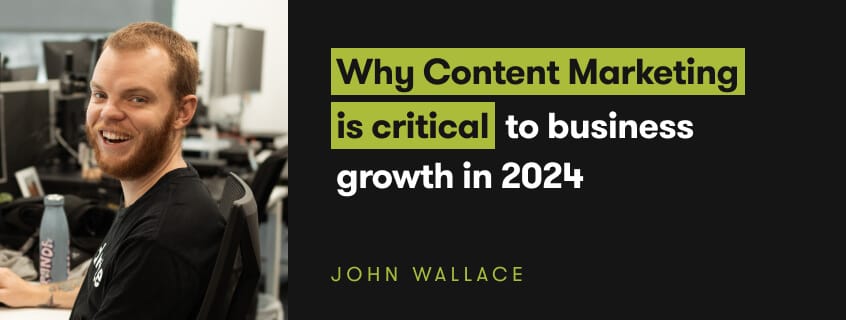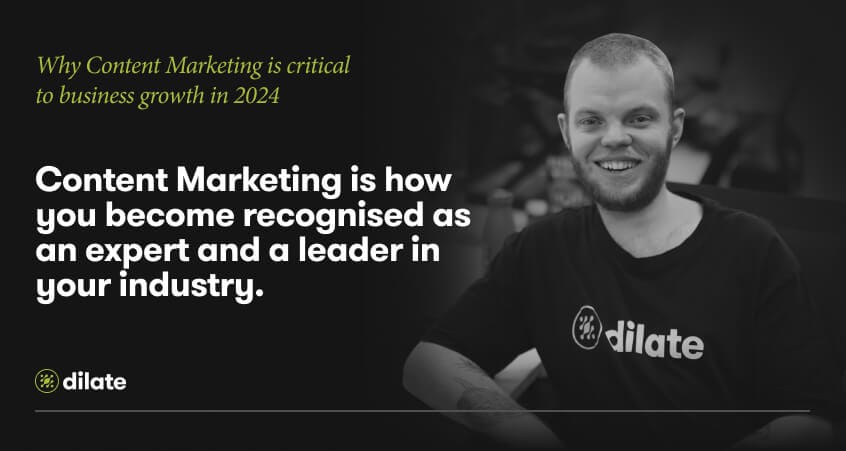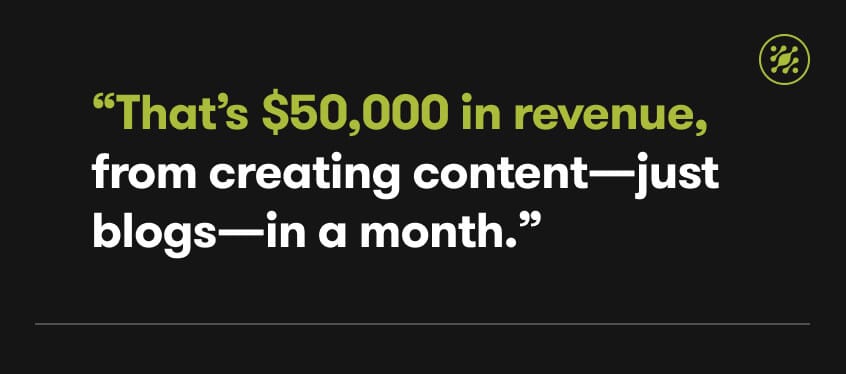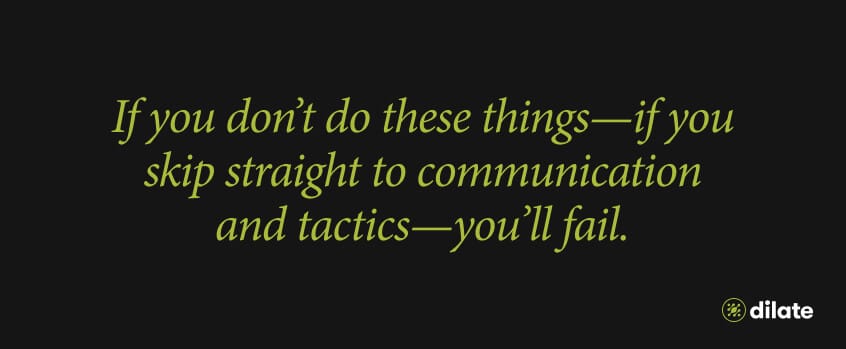

Why is content marketing important? Content is everywhere, it’s the words on webpages, the videos you watch on YouTube and the social media posts you interact with. Whether it's offline or online, in traditional marketing or digital marketing, content is how you reach people and build an audience, communicate your message and impact the market. There’s even an argument to be made that ads are just content, albeit with a clear goal.
In a way, content is the basis of everything in marketing. It’s the vessel you use to communicate to the market what your brand is all about, and why people should choose you over a competitor. Without content, you’re missing out on capturing your ideal customer’s attention—you’re relying on them finding you when they’re ready to make a purchase… somehow.
There’s a catch to content though. It’s incredibly easy to do it wrong, and spend huge amounts of time and money producing content that no-one consumes, or worse—no-one gets any value from. To do content properly, you need a strategy. A plan to produce the right content for the right audience, and share it in the right place, at the right time so that it drives meaningful results for your business. There’s a name for strategic, calculated content creation and distribution– Content Marketing. In 2024, having a good Content Marketing strategy to support and amplify your overall marketing efforts is absolutely essential.
If you’re not convinced, here’s 3 reasons why Content Marketing is so important for your business, and a simple 5-step process to get started. Let’s begin.

One of the most important things about creating content is that it needs to be valuable. If your content isn’t valuable to your audience, it’s just noise. Good content educates, informs and entertains your audience, preparing them to make better purchasing decisions and helping them improve their way of life. You don’t even need to be the ultimate expert in your field to produce valuable content, you just need to be more experienced than your audience and willing to put in the work to find, share and draw conclusions from information.
Creating and distributing valuable, informative content positions you, your business and your brand as an expert in your field. Helping people to understand a topic, make better decisions or achieve something will build respect, loyalty and brand familiarity. Think about it, if someone teaches you how to do something, and then you see their brand when shopping for a product, you’re probably going to want to buy from them. This is because you’ve developed trust for that brand, you’ve experienced their value and you’re familiar with them. Familiarity and trust are massive psychological factors that influence a customer’s purchasing decision.
If you’re convinced content marketing is what you want, but are thinking about getting someone else to do it for you—why not check out our Organic Marketing service. We’ll create content, distribute it and optimise it all for you. So you can focus on running your business and doing what you do best.
That was an example of how to leverage the trust and respect you’ve built with your audience, and offer a solution to their problem. Ideally, you want to be offering this solution just before they’re looking for it. This makes their journey smooth and effortless, as you’ve anticipated the problem they’ll need solved next.
By creating high-quality, valuable and relevant content you know your target audience loves, you'll get their attention and make a lasting impression, positioning yourself as a leader in your industry.
If you’re creating content in a very reactive way, where you’re always asking “what should we post next?”, it’s going to be time consuming and expensive. But done right, content marketing is all about creating resources that are ‘evergreen’. This means creating content that stays relevant and valuable to people over time. To do this, you need to spend more time in the planning and strategy phase. At Dilate, we spend a lot of time understanding the market, your customer and the journey they go on before they’re ready to purchase a product or service. We’re looking for what questions they ask, what information they need to know and what tangential interests they might have.
One of the main things that makes content marketing different to just creating content is how you go about getting people to actually consume said content. Marketing is all about understanding your market, how people behave and what they want—and giving that to them. With organic content marketing, one of the core (and easiest!) ways we understand what people want is through search query data. Essentially, we’re looking at keywords (what people search in Google) and how frequently those queries are searched each month. This data comes from Google directly, and other third-party data/SEO research SaaS companies (like Ahrefs and Semrush). By understanding the intent behind what people are searching, we can create content specific to these search queries that rank in Google, Bing and so on.
By ranking our content in Google’s search results (written content on our blogs, and video content on YouTube channels, for example), we can get it in front of our predetermined target audience. This leads to free, consistent traffic to our content.
Now that we’ve met the right people in the right place, all we need to do is make sure we’re providing them with real value, and the right message. While it can be difficult and time consuming to create content that not only ranks in Google, but satisfies the search intent of your visitors and provides value—the result is worth it.
One of the notable content-related wins we’ve had here at Dilate was for a client in the building materials ecommerce space. We grew their monthly blog traffic from essentially nothing, to enough traffic to drive over $50,000 of additional sales in a single month. That’s $50,000 in revenue, from creating content—just blogs—in a month.

The most exciting part is that there’s still room to grow that particular content operation; to reach new channels and platforms, and produce content on more varied topics.
Whether you’re running a small to medium business with no marketing department, or a large enterprise with an in-house marketing team, an organic content strategy is one of the most cost-effective ways to drive brand awareness—while simultaneously building strong relationships with your target audience.
Over the years we’ve been in business, we’ve had to change our approach to Digital Marketing, specifically the organic side, as the landscape evolved. This has been for a wide variety of reasons, but the main takeaway is this—Google’s mission has always been to connect people with the best content, but their algorithms have taken a long time to get to the point where they can do this effectively.
SEO has always referred to the practice of making your site more appealing to Google, and therefore ranking higher in the SERPs (Search Engine Results Page). However, early SEO was about keyword stuffing—just cram in as many keywords as you can and you’ll rank first. It’s since evolved many, many times, through many huge shifts in their algorithm’s coding. Modern SEO isn’t anything like old SEO, and realistically… it’s not really accurate to call a proper, online organic marketing ‘SEO’, any more.
You can read all about how our approach to digital marketing has changed in this blog, but the quick rundown is that digital marketing is basically traditional marketing, on the internet. That seems obvious, but it’s important to mention because it hasn’t always been that way. Mark Ritson is a renowned marketer who’s done quite a few talks disparaging the concept of “digital” marketing. His point was that it shouldn’t be any different to traditional marketing, and that taking the attitude it was, was a foolish idea. A few years ago I would have disagreed with him—the tactics specific to digital marketing made it quite a different game.
Today, I agree completely. In today’s era of marketing, the word “digital” should only be used to indicate marketing that happens online. In truth, in 2024 success online will require exactly the same approach as traditional marketing. You must understand your customer intimately, know the market like the back of your hand and clearly position and differentiate yourself against your competitors. If you don’t do these things—if you skip straight to communication and tactics—you’ll fail. It’s that simple.

Organic Marketing is what we call our service that gets your content in front of the right people, at the right time. This content isn’t just blogs—like the one you’re reading now—but includes landing pages, your homepage, product pages and more. Because it’s all content, and if you’re not paying for the traffic to those pages—you’re earning it organically (through Google, social media and so on).
Content marketing is relatively simple to get started with, but a solid process makes achieving results much more reliable. Your content marketing efforts should serve your general marketing objectives, which should serve your brand strategy, which in turn aims to achieve your business goals.
At Dilate, we're in the business of building businesses through creative, results-driven marketing. We’re a performance advertising & marketing agency blended with a creative production house. If you want to grow your business in this digital era and want a little bit of guidance, don’t hesitate to give us a call or send us an enquiry.
what our clients are saying
create business. better everyday.
Let's Talklearn from the best minds in the business
Bodie provides some insight into Dilate's internal operations. How we approach what we do, and how we strive to be Better Everyday.





